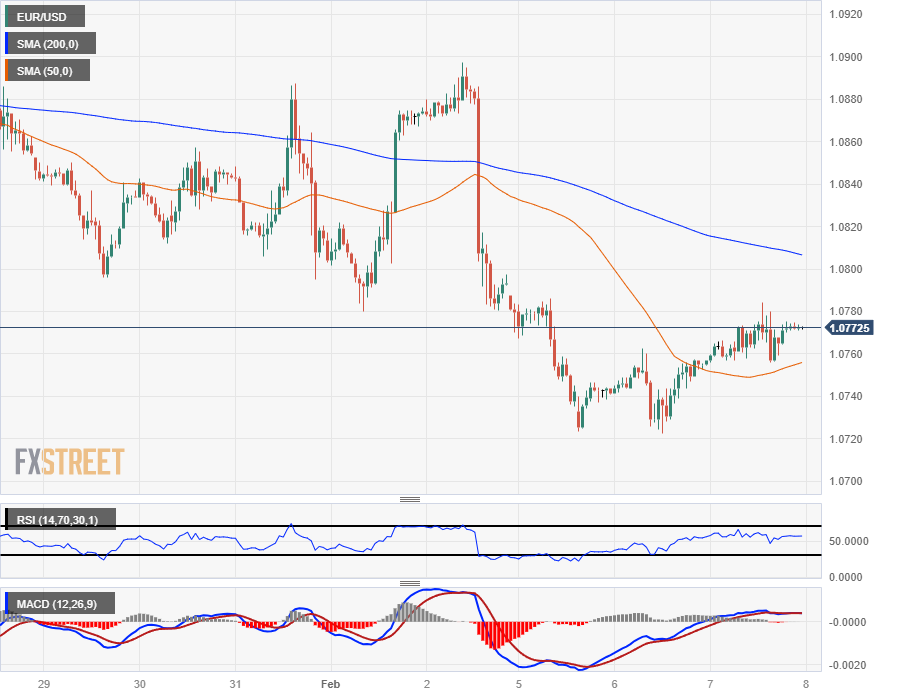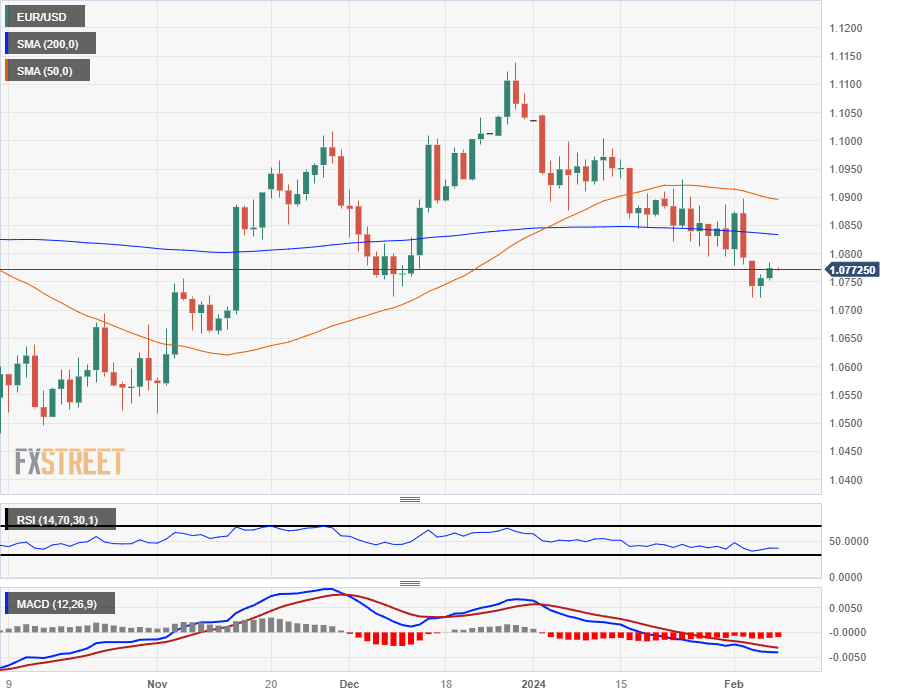- EUR/USD saw little momentum in thin Wednesday action.
- European economic data continues to soften.
- Friday’s Germany HICP inflation to be key release this week.
EUR/USD saw a thin grind higher on Wednesday amidst a mid-day dip-and-rally in the US market session followed by a slim recovery into the day’s mid-range. The pair tested back into familiar territory near 1.0750 after touching a minor intraday high of 1.0784.
European economic figures continue to soften, with multiple mid-week prints missing expectations. Rate cut seekers will be keeping a close eye on Thursday’s European Central Bank (ECB) Economic Bulletin for clues about how close the ECB is to giving markets a rate cut after rates in the euro area hit their current peak last September.
Daily digest market movers: EUR/USD churns below 1.0800 in tight Wednesday trading
- Germany’s MoM Industrial Production declined more than expected in December, printing -1.6% versus the forecast -0.4%. November’s -0.7% saw an upside revision to -0.2%.
- The ECB’s latest Economic Bulletin is slated for release at 09:00 GMT on Thursday.
- ECB’s Elderson, Lane also slated to speak on Thursday.
- Germany’s annualized Harmonized Index of Consumer Prices (HICP) inflation due Friday will be a key data print for the Euro (EUR) this week.
- Germany’s HICP inflation is forecast to hold steady at 3.1% for the year ended January.
- Federal Reserve (Fed) of Minneapolis President Neel Kashkari reaffirms Fed’s rate cut assessment for 2024, sees only 2 or 3 rate cuts through the end of the year.
- Fed’s Kashkari reiterates the need to be patient and take the time to assess data before the Fed makes any cuts.
- Fed Board of Governors member Adriana D. Kugler noted on Wednesday that inflation is progressing in-line with the Fed’s goals, but there’s still more work to be done.
- Fed’s Kugler: remains optimistic on inflation, sees rate cuts as long as price growth continues to recede.
- Fed’s Kugler warns that still-high consumption poses a threat to progress on disinflation as spending remains an elevated contribution to Gross Domestic Product (GDP) growth in the fourth quarter.
Euro price this week
The table below shows the percentage change of Euro (EUR) against listed major currencies this week. Euro was the strongest against the Swiss Franc.
| USD | EUR | GBP | CAD | AUD | JPY | NZD | CHF | |
| USD | 0.07% | -0.05% | -0.05% | -0.23% | -0.30% | -0.82% | 0.84% | |
| EUR | -0.07% | -0.11% | -0.12% | -0.30% | -0.37% | -0.88% | 0.77% | |
| GBP | 0.03% | 0.09% | -0.01% | -0.20% | -0.29% | -0.79% | 0.87% | |
| CAD | 0.06% | 0.12% | 0.00% | -0.17% | -0.26% | -0.76% | 0.89% | |
| AUD | 0.22% | 0.30% | 0.20% | 0.21% | -0.07% | -0.58% | 1.07% | |
| JPY | 0.30% | 0.36% | 0.24% | 0.26% | 0.08% | -0.52% | 1.14% | |
| NZD | 0.80% | 0.89% | 0.78% | 0.76% | 0.57% | 0.50% | 1.64% | |
| CHF | -0.85% | -0.78% | -0.88% | -0.91% | -1.07% | -1.18% | -1.68% |
The heat map shows percentage changes of major currencies against each other. The base currency is picked from the left column, while the quote currency is picked from the top row. For example, if you pick the Euro from the left column and move along the horizontal line to the Japanese Yen, the percentage change displayed in the box will represent EUR (base)/JPY (quote).
Technical Analysis: EUR/USD remains pinned below 1.0800
EUR/USD continues to trade on the south side of the 1.0800 handle in the mid-week, with the pair capped below the 200-hour Simple Moving Average (SMA) after getting rejected from the 1.0900 region last week.
EUR/USD continues to trade into the low side of a congestion zone between the 50-day and 200-day SMAs near 1.0900 and 1.0850 respectively, but downside momentum remains limited. The pair risks getting pulled back into consolidation above 1.0800 if sellers aren’t able to push the EUR/USD back under December’s low bids near 1.0725.
EUR/USD hourly chart
EUR/USD daily chart
Euro FAQs
The Euro is the currency for the 20 European Union countries that belong to the Eurozone. It is the second most heavily traded currency in the world behind the US Dollar. In 2022, it accounted for 31% of all foreign exchange transactions, with an average daily turnover of over $2.2 trillion a day.
EUR/USD is the most heavily traded currency pair in the world, accounting for an estimated 30% off all transactions, followed by EUR/JPY (4%), EUR/GBP (3%) and EUR/AUD (2%).
The European Central Bank (ECB) in Frankfurt, Germany, is the reserve bank for the Eurozone. The ECB sets interest rates and manages monetary policy.
The ECB’s primary mandate is to maintain price stability, which means either controlling inflation or stimulating growth. Its primary tool is the raising or lowering of interest rates. Relatively high interest rates – or the expectation of higher rates – will usually benefit the Euro and vice versa.
The ECB Governing Council makes monetary policy decisions at meetings held eight times a year. Decisions are made by heads of the Eurozone national banks and six permanent members, including the President of the ECB, Christine Lagarde.
Eurozone inflation data, measured by the Harmonized Index of Consumer Prices (HICP), is an important econometric for the Euro. If inflation rises more than expected, especially if above the ECB’s 2% target, it obliges the ECB to raise interest rates to bring it back under control.
Relatively high interest rates compared to its counterparts will usually benefit the Euro, as it makes the region more attractive as a place for global investors to park their money.
Data releases gauge the health of the economy and can impact on the Euro. Indicators such as GDP, Manufacturing and Services PMIs, employment, and consumer sentiment surveys can all influence the direction of the single currency.
A strong economy is good for the Euro. Not only does it attract more foreign investment but it may encourage the ECB to put up interest rates, which will directly strengthen the Euro. Otherwise, if economic data is weak, the Euro is likely to fall.
Economic data for the four largest economies in the euro area (Germany, France, Italy and Spain) are especially significant, as they account for 75% of the Eurozone’s economy.
Another significant data release for the Euro is the Trade Balance. This indicator measures the difference between what a country earns from its exports and what it spends on imports over a given period.
If a country produces highly sought after exports then its currency will gain in value purely from the extra demand created from foreign buyers seeking to purchase these goods. Therefore, a positive net Trade Balance strengthens a currency and vice versa for a negative balance.
Source: https://www.fxstreet.com/news/eur-usd-slow-grind-sees-little-progress-as-pair-struggles-near-10750-202402071654